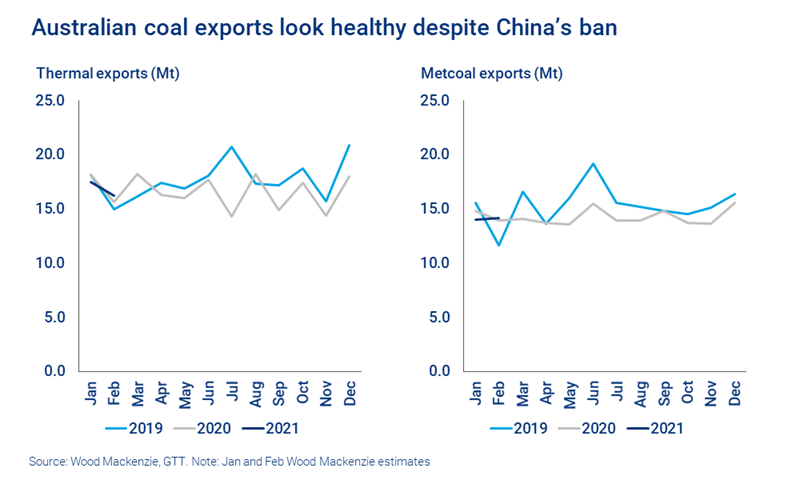Australian coal exports bounce back from China’s ban
Australia’s coal exporters have staged a recovery after volumes to China plummeted
1 minute read
Rory Simington
Principal Analyst APAC Thermal Coal Research

Rory Simington
Principal Analyst APAC Thermal Coal Research
Rory Simington is a research analyst with over twenty years' experience in the Australian mining industry.
Latest articles by Rory
-
Opinion
Australian coal exports bounce back from China’s ban
-
Opinion
China's thermal coal import restriction could mean a game of musical chairs for producers
In October 2020 China implemented a ban on clearing or discharging Australian coal with immediate effect, followed by a hard stop on cargoes received after 6 November. Australian exports to China have since plummeted, from 6-12 Mt per month to effectively zero.
But despite this setback, Australia’s exporters have staged a recovery. What’s behind the bounce back, and how have trade flows changed?
This article is an extract from Australian coal exports bounce back despite China ban. Fill in the form to read the insight in full and access the full set of charts.
Australian exports could exceed previous years
Beijing’s restriction on the coal trade are nothing new, with import quotas first introduced in Q3 2018 to support domestic producers. But things changed in 2020 with a chill in diplomatic relations between China and Australia leading to Beijing targeting a multitude of Australian products. The list grew to include wine, timber, rock lobsters, copper concentrates and sugar. When China implemented its ban on Australian coal in October there were understandable fears for exporters.
However, at the end of 2020 we saw a significant shift in thermal coal trade flows, while a reshaping of metallurgical coal trade flows also appears to be well underway.
Our projections for Australian exports in January and February are looking healthy. In fact, February exports look like they will be higher than in both 2020 and 2019.
Higher prices support revenue recovery
It’s not just export volumes. Higher prices have meant that export revenue has also staged a significant recovery. Our projections are that February export revenues for both thermal and metallurgical coal will be roughly the same as they were in 2019 – and higher than the 2020 average. Along with volume recovery, a big part of this was the thermal coal price recovery at the end of 2020, and a more recent increase in coking coal prices.
Key drivers of higher prices have included Chinese demand fuelled by a significant economic and industrial recovery, an extremely cold winter, constrained domestic production and tight import controls. Shortages of coal in the domestic market pushed Chinese consumers into the seaborne market. Because of the ban, these consumers were restricted to destinations other than Australia, resulting in pricing disparity between Australian coal and coal from other origins.
For more detail on export revenues, delivered spot pricing and the arbitrage for premium coking coal, fill in the form to read this report in full.
Trade flows have rebalanced
Distortions in the market caused by China’s ban have resulted in a rebalancing of trade flows, with Australian exports increasing to ex-China markets.
Australian metallurgical coal exports to China fell to a bare 0.2 Mt in December, while monthly exports hit their highest level of the year at 15.6 Mt (187 Mtpa annualised). Brazil and India were early movers to take advantage. Monthly exports to India hit a record in December at 5.6 Mt, beating the previous record of 5.1 Mt set only three months prior. Exports to Brazil in December were almost 7 Mtpa annualised. We also noted a pick-up in exports to Indonesia.
Australian thermal coal exports to China also fell to 0.2 million tonnes in December. Buyers in India switched to Australian thermal coal as Indonesian and even South African coal faced a surge in buying from China. Exports to India reached a record in December as a result.
How has buying activity shifted across other markets? Read the full insight to find out more.
Domestic prices in China remain high
Chinese buyers have been paying very high prices for imports, but it’s still cheaper than domestic material. Domestic thermal coal prices have dropped significantly to around 650 RMB/t from a peak of 1,100 RMB/t (US$190/t) in January. However, even after this decline domestic prices are US$13/t higher than for imported material.
How might this affect the market in 2021? Will current pricing arbitrages support seaborne market pricing – including for Australian coal? Read the full report to find out more, with charts including:
- Australian coal export revenue
- Annualised metallurgical and thermal coal exports to key markets
- Price differentials, low volume prime HCC and thermal coal







